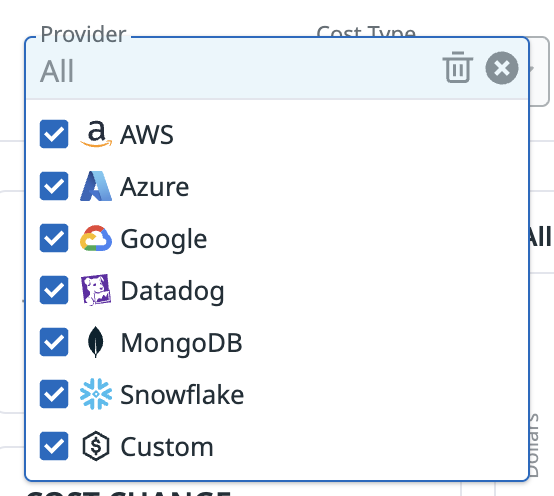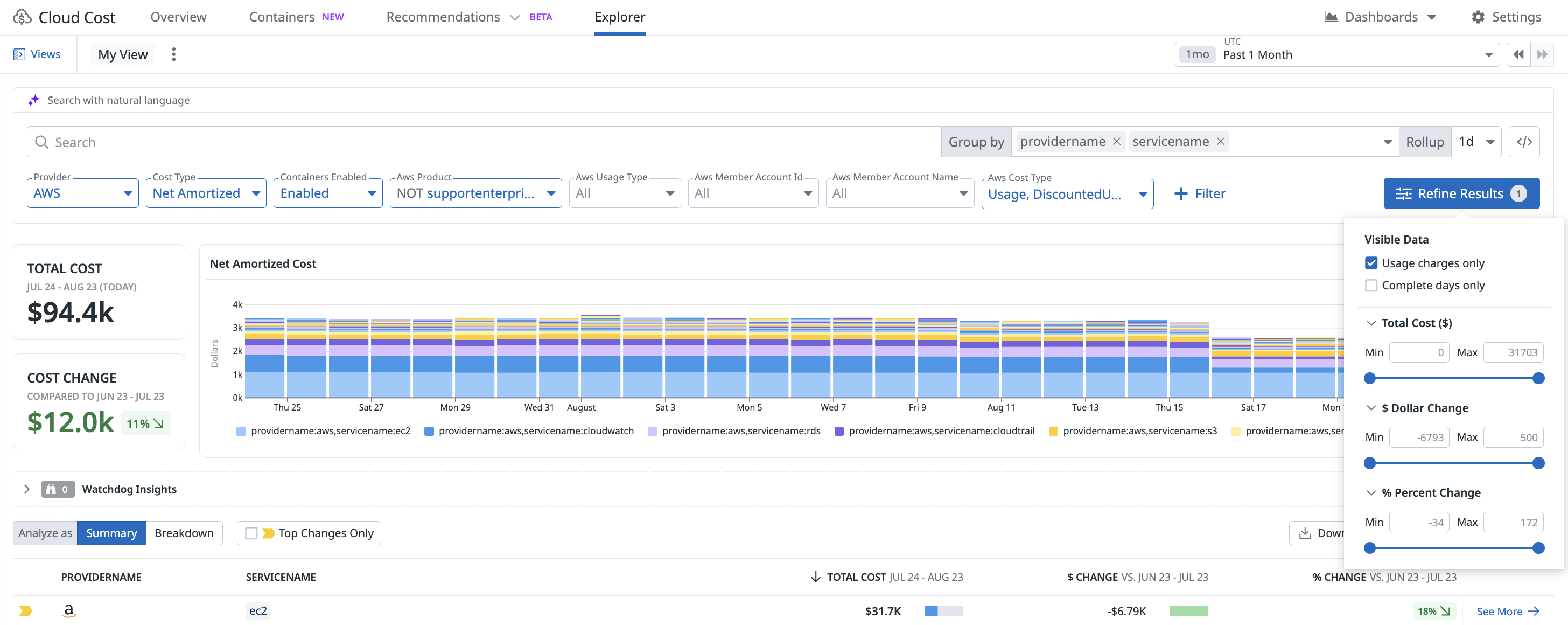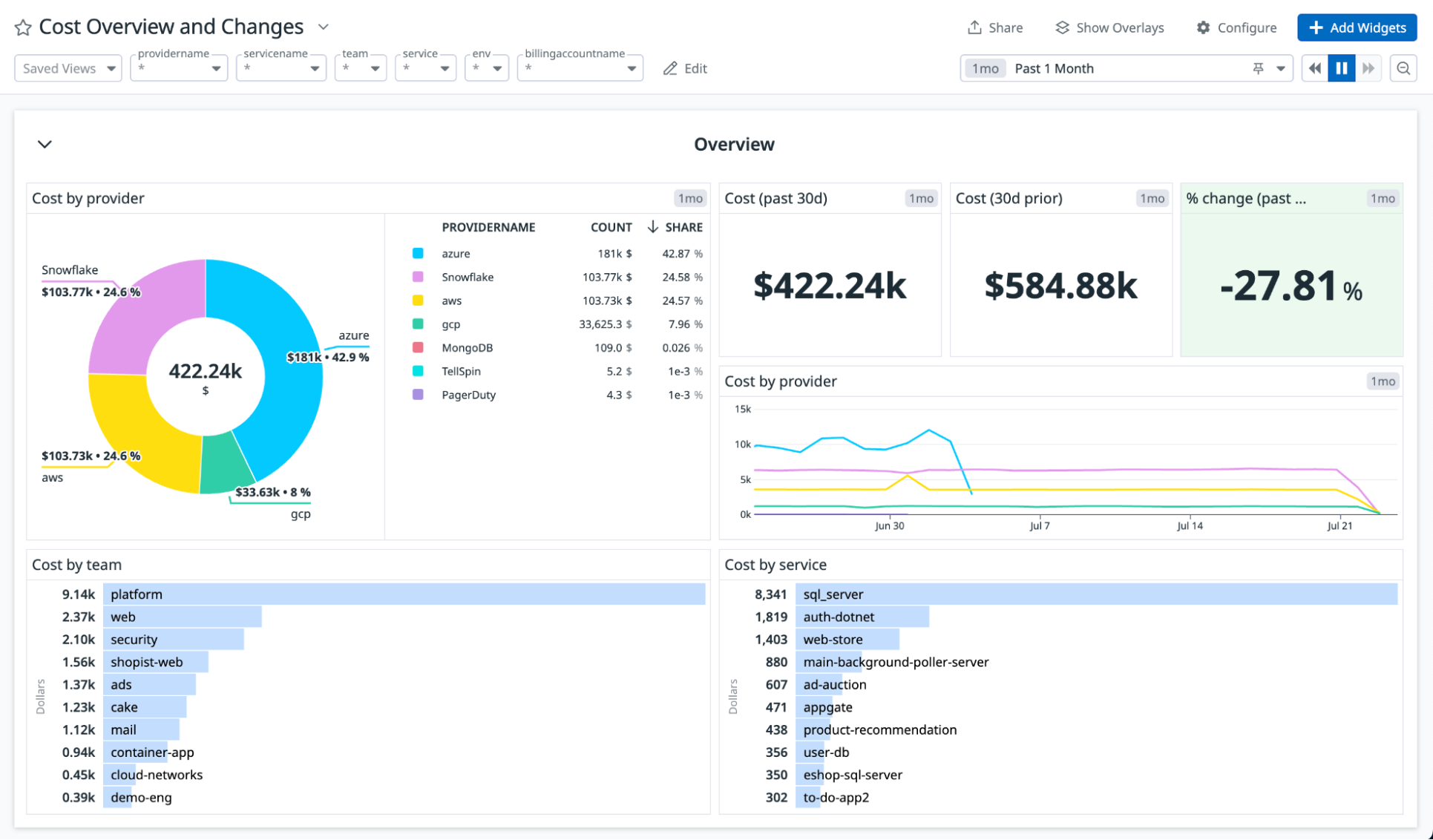- Esenciales
- Empezando
- Agent
- API
- Rastreo de APM
- Contenedores
- Dashboards
- Monitorización de bases de datos
- Datadog
- Sitio web de Datadog
- DevSecOps
- Gestión de incidencias
- Integraciones
- Internal Developer Portal
- Logs
- Monitores
- OpenTelemetry
- Generador de perfiles
- Session Replay
- Security
- Serverless para Lambda AWS
- Software Delivery
- Monitorización Synthetic
- Etiquetas (tags)
- Workflow Automation
- Centro de aprendizaje
- Compatibilidad
- Glosario
- Atributos estándar
- Guías
- Agent
- Arquitectura
- IoT
- Plataformas compatibles
- Recopilación de logs
- Configuración
- Automatización de flotas
- Solucionar problemas
- Detección de nombres de host en contenedores
- Modo de depuración
- Flare del Agent
- Estado del check del Agent
- Problemas de NTP
- Problemas de permisos
- Problemas de integraciones
- Problemas del sitio
- Problemas de Autodiscovery
- Problemas de contenedores de Windows
- Configuración del tiempo de ejecución del Agent
- Consumo elevado de memoria o CPU
- Guías
- Seguridad de datos
- Integraciones
- Desarrolladores
- Autorización
- DogStatsD
- Checks personalizados
- Integraciones
- Build an Integration with Datadog
- Crear una integración basada en el Agent
- Crear una integración API
- Crear un pipeline de logs
- Referencia de activos de integración
- Crear una oferta de mercado
- Crear un dashboard de integración
- Create a Monitor Template
- Crear una regla de detección Cloud SIEM
- Instalar la herramienta de desarrollo de integraciones del Agente
- Checks de servicio
- Complementos de IDE
- Comunidad
- Guías
- OpenTelemetry
- Administrator's Guide
- API
- Partners
- Aplicación móvil de Datadog
- DDSQL Reference
- CoScreen
- CoTerm
- Remote Configuration
- Cloudcraft
- En la aplicación
- Dashboards
- Notebooks
- Editor DDSQL
- Reference Tables
- Hojas
- Monitores y alertas
- Watchdog
- Métricas
- Bits AI
- Internal Developer Portal
- Error Tracking
- Explorador
- Estados de problemas
- Detección de regresión
- Suspected Causes
- Error Grouping
- Bits AI Dev Agent
- Monitores
- Issue Correlation
- Identificar confirmaciones sospechosas
- Auto Assign
- Issue Team Ownership
- Rastrear errores del navegador y móviles
- Rastrear errores de backend
- Manage Data Collection
- Solucionar problemas
- Guides
- Change Tracking
- Gestión de servicios
- Objetivos de nivel de servicio (SLOs)
- Gestión de incidentes
- De guardia
- Status Pages
- Gestión de eventos
- Gestión de casos
- Actions & Remediations
- Infraestructura
- Cloudcraft
- Catálogo de recursos
- Universal Service Monitoring
- Hosts
- Contenedores
- Processes
- Serverless
- Monitorización de red
- Cloud Cost
- Rendimiento de las aplicaciones
- APM
- Términos y conceptos de APM
- Instrumentación de aplicación
- Recopilación de métricas de APM
- Configuración de pipelines de trazas
- Correlacionar trazas (traces) y otros datos de telemetría
- Trace Explorer
- Recommendations
- Code Origin for Spans
- Observabilidad del servicio
- Endpoint Observability
- Instrumentación dinámica
- Live Debugger
- Error Tracking
- Seguridad de los datos
- Guías
- Solucionar problemas
- Límites de tasa del Agent
- Métricas de APM del Agent
- Uso de recursos del Agent
- Logs correlacionados
- Stacks tecnológicos de llamada en profundidad PHP 5
- Herramienta de diagnóstico de .NET
- Cuantificación de APM
- Go Compile-Time Instrumentation
- Logs de inicio del rastreador
- Logs de depuración del rastreador
- Errores de conexión
- Continuous Profiler
- Database Monitoring
- Gastos generales de integración del Agent
- Arquitecturas de configuración
- Configuración de Postgres
- Configuración de MySQL
- Configuración de SQL Server
- Configuración de Oracle
- Configuración de MongoDB
- Setting Up Amazon DocumentDB
- Conexión de DBM y trazas
- Datos recopilados
- Explorar hosts de bases de datos
- Explorar métricas de consultas
- Explorar ejemplos de consulta
- Exploring Database Schemas
- Exploring Recommendations
- Solucionar problemas
- Guías
- Data Streams Monitoring
- Data Jobs Monitoring
- Data Observability
- Experiencia digital
- Real User Monitoring
- Pruebas y monitorización de Synthetics
- Continuous Testing
- Análisis de productos
- Entrega de software
- CI Visibility
- CD Visibility
- Deployment Gates
- Test Visibility
- Configuración
- Network Settings
- Tests en contenedores
- Repositories
- Explorador
- Monitores
- Test Health
- Flaky Test Management
- Working with Flaky Tests
- Test Impact Analysis
- Flujos de trabajo de desarrolladores
- Cobertura de código
- Instrumentar tests de navegador con RUM
- Instrumentar tests de Swift con RUM
- Correlacionar logs y tests
- Guías
- Solucionar problemas
- Code Coverage
- Quality Gates
- Métricas de DORA
- Feature Flags
- Seguridad
- Información general de seguridad
- Cloud SIEM
- Code Security
- Cloud Security Management
- Application Security Management
- Workload Protection
- Sensitive Data Scanner
- Observabilidad de la IA
- Log Management
- Observability Pipelines
- Gestión de logs
- CloudPrem
- Administración
- Gestión de cuentas
- Seguridad de los datos
- Ayuda
Multisource Querying
Información general
Una vez que empieces a ingerir tus costes de AWS, Azure, Google Cloud, SaaS o Datadog en Cloud Cost Management, podrás consultar los costes de todos los proveedores de forma flexible. Multisource Querying te permite consultar los costes de varios proveedores utilizando etiquetas (tags) de forma constante y estandarizada, en lugar de crear varias consultas para cada proveedor.
Utiliza Multisource Querying para crear vistas de costes, comprender el coste total de propiedad del servicio y recibir alertas sobre cambios y tendencias de costes en la página Explorer, en dashboards, en notebooks y en costes de monitores.
Configuración
Para utilizar Multisource Querying, asegúrate de haber configurado Cloud Cost Management y de estar ingiriendo costes de forma activa en Datadog. Se admiten varias divisas y los costes se convierten automáticamente a USD y se muestran en USD.
Consultar datos de tus costes
Puedes seleccionar varios proveedores en el campo Provider (Proveedor) de la página Explorer.
Los filtros desplegables como Proveedor y Equipo mantienen la flexibilidad y agilizan el proceso de crear una consulta de búsqueda para que puedas refinar los datos de tus costes. Para añadir un filtro, haz clic en + Filter (+ Filtro).
Haz clic en Refine Results (Refinar resultados) para acceder a las siguientes opciones y filtrar los datos de tus costes.
- Sólo gastos de uso
- Examina los costes afectados por los equipos de ingeniería, excluyendo créditos, tasas e impuestos.
- Sólo días completos
- Excluye los dos últimos días de datos de costes, que están incompletos.
- Coste total
- Filtra los datos para ver los costes dentro de un intervalo de costes específico.
- Cambio de dólar
- Muestra sólo los cambios de costes dentro de un rango de cambio de dólar especificado.
- Cambio porcentual
- Muestra sólo los cambios de costes dentro de un rango de cambio porcentual especificado.
Visualizar los datos de tus costes
Con Multisource Querying, puedes crear visualizaciones utilizando los datos de costes de todos los proveedores en tus dashboards.
Datos recopilados
Métrica de costes
Multisource Querying utiliza la métrica all.cost, que combina todas las métricas de costes individuales de nube y SaaS en una vista unificada en la página Analytics.
Nota: La métrica all.cost no incluye etiquetas de nivel de recurso. Para ver los costes por recurso, utiliza las métricas de coste específicas de cada proveedor (como aws.cost.amortized). Cuando se filtra a un proveedor específico en la consulta de búsqueda, Datadog cambia automáticamente a la métrica específica del proveedor correspondiente, lo que permite realizar una consulta más detallada de los datos de costes.
Etiquetas predefinidas
Cloud Cost Management recopila etiquetas para las integraciones AWS, Azure y Google Cloud. Esta tabla proporciona una lista no exhaustiva de etiquetas compartidas por cada integración.
| Nombre de la etiqueta | Descripción de la etiqueta |
|---|---|
allocated_resource | Tipo de recurso utilizado por una carga de trabajo de contenedor (como cpu o mem). |
allocated_spend_type | Los costes por contenedor se dividen en tres tipos de gastos: recursos utilizados por una carga de trabajo (usage); recursos reservados por una carga de trabajo, pero no utilizados (workload_idle); y recursos no reservados ni utilizados por ninguna carga de trabajo (cluster_idle). |
ecs_cluster_name | Nombre del clúster ECS que aloja una carga de trabajo. |
kube_cluster_name | Nombre del clúster Kubernetes que aloja una carga de trabajo. |
orchestrator | Orquestador del contenedor (como kubernetes o ecs). |
Enriquecimiento de etiquetas
Cloud Cost Management enriquece todos los datos de costes de los proveedores con etiquetas que adhieren a la especificación FinOps FOCUS. FOCUSTM es una especificación técnica que normaliza los datos de costes y la facturación por uso entre proveedores de nube.
Las etiquetas de FOCUS te permiten consultar conceptos similares entre proveedores. Por ejemplo, si quieres ver el coste por cuenta en AWS y Azure, no es necesario crear dos consultas (una para los costes de AWS agrupados por aws_member_account_name y otra para los costes de Azure agrupados por subscriptionname). Puedes utilizar una consulta de búsqueda que filtre los costes de AWS y Azure agrupados por subaccountname.
Cloud Cost Management añade versiones en minúsculas de los ID de columnas de especificaciones a todas las métricas de costes.
Las siguientes etiquetas de FOCUS están disponibles en Cloud Cost Management:
| Nombre de la etiqueta | Descripción de la etiqueta |
|---|---|
providername | Nombre de la entidad que puso a la venta recursos o servicios. |
servicename | Oferta que se puede adquirir a un proveedor (por ejemplo, máquina virtual en la nube, base de datos SaaS, servicios profesionales de un integrador de sistemas). |
billingaccountid | Identificador asignado a una cuenta de facturación por el proveedor. |
billingaccountname | Nombre para mostrar, asignado a una cuenta de facturación. |
billingcurrency | La divisa en la que se pagó una factura de nube. |
subaccountid | Identificador asignado a una agrupación de recursos o servicios, utilizado a menudo para gestionar el acceso o los costes. |
subaccountname | Nombre asignado a una agrupación de recursos o servicios, utilizado a menudo para gestionar el acceso o los costes. |
regionname | Nombre de una zona geográfica aislada en la que se suministra un recurso o se proporciona un servicio. |
availabilityzone | Identificador asignado por el proveedor a un área físicamente separada y aislada dentro de una región que proporciona alta disponibilidad y tolerancia a fallos. |
pricingunit | Unidad de medida especificada por el proveedor para determinar los precios unitarios, que indica cómo valora el proveedor el uso medido y las cantidades de compras tras aplicar reglas de precios como la tarificación por bloques. |
La métrica all.cost tiene costes de contenedor asignados para costes de AWS, Azure y Google Cloud, por lo que se pueden realizar consultas por las etiquetas de contenedor relevantes.
Si tu organización utiliza cualquiera de estas etiquetas de FOCUS, Datadog recomienda actualizar tu clave de etiquetas en la infraestructura subyacente para que los valores de las etiquetas no se superpongan a los valores de las etiquetas de FOCUS en Cloud Cost Management.
Conversión de divisas
Cloud Cost Management recupera la divisa de facturación de la factura de cada proveedor de nube. Cuando procesas costes de múltiples proveedores en diferentes divisas, los cargos por costes se convierten a USD. Esta conversión se realiza al tipo de cambio medio mensual, que se actualiza diariamente. Esto garantiza que Cloud Cost Management pueda representar de forma coherente y precisa todos los datos de costes, independientemente de su divisa original. Para ver tu coste en la divisa original de facturación, filtra a un único proveedor.
Referencias adicionales
Más enlaces, artículos y documentación útiles:




